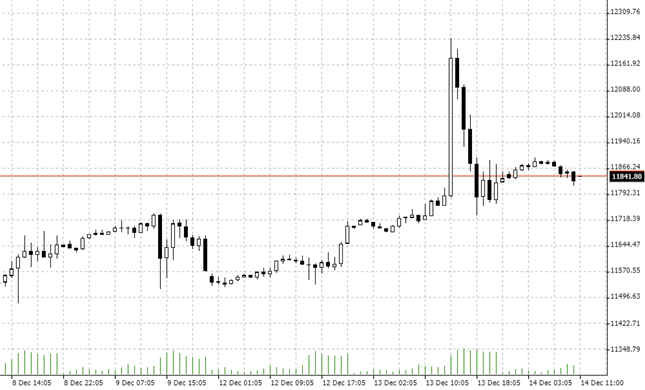

14.12.2022 – Pre-Christmas presents for the bulls on the stock market. Part one is behind us: US inflation turned out a little cooler than expected. Part two may follow shortly: The Federal Reserve is in session and, as always, much, if not all, depends on Fed Chairman Jerome Powell’s wording.
As always, the following also applies: Don’t trade around the Fed. Those who do not want to be stopped out in wild swings should hold back today. A small foretaste of the market reaction to important events was provided by the Nasdaq 100, which reacted to the Consumer Price Index. The picture shows the hourly chart. The shares went up at first, then they went down. On the trading floor it could be heard that many brokers preferred to take profits before today’s Fed event.

Source: Bernstein Bank GmbH
In view of the current economic situation, with the risk of a recession still smouldering, many also see valuations as being pretty much exhausted. And we are still at an inflation rate of 7.1 per cent – the consensus was 7.3 per cent, the previous figure was 7.7 per cent. That’s a long way from the Fed’s target of 2.0 per cent.
Waiting for normalisation
Oxford Economics stated: “it will take time for price trends to normalise, but 2023 is expected to bring healthier inflation readings, and as such look for goods inflation to retreat as goods demand eases and supply-chain conditions normalise.” Services inflation will be more stubborn, but it too will diminish – especially as rental inflation cools. More encouraging inflation dynamics will allow the Fed to end its rate hikes early next year.”
The market sees 50 basis points
So it’s the Fed today. Most forecasters believe in a rate hike of 50 basis points today, at least that is the result of a Reuters poll of 84 analysts. Oxford Eco also sees a 50bps rate move now, then another 25bps in February 2023. Expectations for another 50bps move after that are melting away. JPMorgan expects the rate hike cycle to end in the second quarter of 2023.
The majority of the stock market now expects a Fed funds rate of 4.75 to 5.00 per cent as the terminal rate – i.e. the end of the line for interest rates. So there is still a little room for improvement, as the US key interest rate is currently quoted at 3.75 to 4.00 per cent. Bernstein Bank is looking forward to the Fed’s statements – we wish you successful trades and investments!
__________________________________________________________________________________________
The content of this publication is for general information purposes only. In this context, it is neither an individual investment recommendation or advice nor an offer to purchase or sell securities or other financial products. The content in question and all the information contained therein do not in any way replace individual investor- or investment-oriented advice. No reliable forecast or indication for the future is possible with respect to any presentation or information on the present or past performance of the relevant underlying assets. All information and data presented in this publication are based on reliable sources. However, Bernstein Bank does not guarantee that the information and data contained in this publication is up-to-date, correct and complete. Securities traded on the financial markets are subject to price fluctuations. A contract for difference (CFD) is also a financial instrument with leverage effect. Against this backdrop, CFD trading involves a high risk up to the point of total loss and may not be suitable for all investors. Therefore, make sure that you have fully understood all the correlating risks. If necessary, ask for independent advice. CFDs are complex instruments and are associated with the high risk of losing money quickly because of the leverage effect. 68% of retail investor accounts lose money trading CFD with this provider. You should consider whether you understand how CFD work and whether you can afford to take the high risk of losing your money.7
